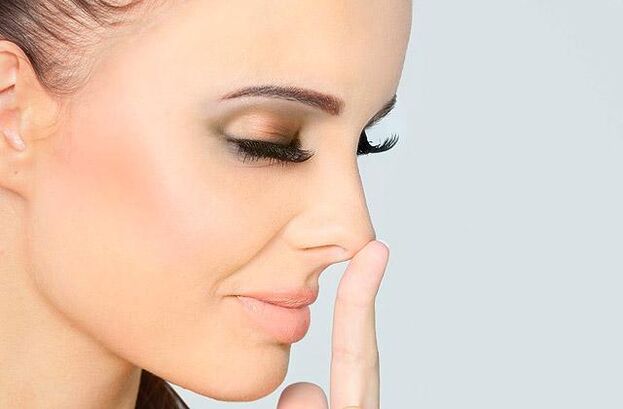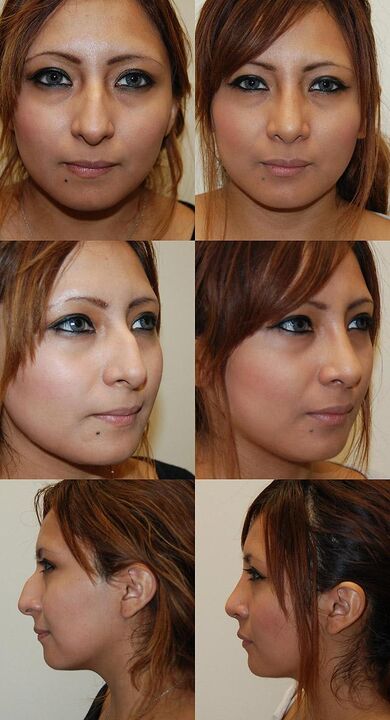Rhinoplasty (nose job) is the correction, restoration, correction of the structures of the nose through plastic surgery techniques. Used for medical and aesthetic reasons.
Despite its prevalence, nasal correction surgeries are still considered one of the most difficult.
Nose repair surgeries have been performed for thousands of years. Ancient manuscripts testify to the successful experience of such procedures long before our era.
Medicine is way ahead of ancient doctors, and modern rhinoplasty is more of a cosmetic procedure than a medical necessity.
Indications for rhinoplasty
Each plastic surgery is a complex creative process that combines the issues of solving aesthetic problems with the preservation or restoration of specific functional characteristics of the organ (in this case, it is nasal breathing).
Thus, rhinoplasty can be performed for therapeutic and aesthetic purposes. The ideal age to drive it is 25 to 35 years old.
The medical indications are:
- congenital nasal septum deformity;
- turbinate polyps and hypertrophy;
- traumatic injuries and post-traumatic changes in bone, cartilage, physiological (due to uneven tissue development) or compensatory curvature of the nasal septum;
- pronounced violation or complete absence of the possibility of nasal breathing.
Changes in the correct anatomical structure of the nose are often the cause of functional and pathological disorders - shortness of breath, atrophy or hypertrophy of the nasal mucosa, rhinosinusitis, otitis media, frequent respiratory diseases, nocturnal snoring.
Furthermore, in children, these defects can cause chronic starvation of oxygen in the brain, which leads not only to physical but also mental retardation, and affects their mental development and behavioral reactions. Therefore, rhinoplasty can also be performed on children under 18 years of age.
More than 60% of the reason for rhinoplasty is the patient's desire to improve the shape of the nose in order to achieve complete harmony in their appearance. The services of plastic surgeons are becoming more and more popular. The aesthetic indications for rhinoplasty are divided into two large groups:
- objective - are disproportionate and unattractive nose sizes or shape;
- subjective, or psychological: there are no specific criteria for evaluating beauty, each person has their established stereotype and therefore, simply for personal reasons, they may not like the nose.
These reasons often affect people's professional and personal relationships, give rise to complexes of dissatisfaction and inferiority itself, especially among women, leads to social maladjustment.
Rhinoplasty for aesthetic purposes is indicated in cases where there is:
- disproportionate size of the nose in relation to the entire face - too big or, conversely, too small;
- congenital or acquired deformities;
- nasal septum curvature;
- nostrils flared, humpback;
- bifurcated, lowered or very high, asymmetrical tip, as well as out of step with the height of the nasal dorsum;
- saddle shape;
- aesthetically unsatisfactory result of the previous operation.
In many cases, the medical and aesthetic indications are the same and result from the same anatomical defects.

Types of Rhinoplasty
According to the objective pursued and the technique for performing the surgical intervention, rhinoplasty is divided into:
According to the same criteria, there are several types of rhinoplasty:
All types of operations are subdivided into:
- primary;
- secondary;
- repeated.
Access techniques
In performing rhinoplasty, depending on the access options, the following techniques are used:
Rhinoplasty of any kind is performed under one of the types of general anesthesia and usually lasts 1 to 2 hours. Sometimes its duration can be as long as three hours or more.
How is rhinoplasty performed?
The operation is performed in the following sequence:
- nasal septum correction is performed;
- if necessary, the nose shells are reduced;
- the nose bulge is corrected if it is necessary to form a uniform profile;
- bones are dissected and displaced to narrow the nose pyramid;
- straightens the nose;
- cutting edge correction.
revision rhinoplasty
Retroplasty of the nose is considered if there is already surgical intervention in this area. Final formation of the nose after plastic surgery takes place in 6 months - 1 year. This period is ideal for reoperation. It is performed when:
- condition of impossibility to reach the goal in one step;
- unsatisfactory results of the primary operation;
- the need to correct the problems that remain after primary rhinoplasty.
According to world statistics, 25-30% of patients undergoing primary rhinoplasty require a second corrective surgery. This is considered normal. It usually takes no more than half an hour and is performed under local anesthesia. Corrective revision rhinoplasty allows you to correct scar deficiencies and bring the shape of the nose to an aesthetic result that meets the needs of the surgeon and the patient.
Repeat rhinoplasty is much more difficult in cases of poorly performed or unfavorable primary evolution of the rehabilitation period, which often depends on the individual characteristics of the body and complications. These operations require deeper examination and more thorough preparation. They represent a complete plastic according to one of the options, but as a rule they end up being much more complicated and time-consuming. Minor flaws during repeated plastic surgery can lead to a final break in the shape, not only of, for example, the tip, but also a pronounced deformation of the entire nose.
Complications and Preparation for Surgery
The nose job is considered one of the most difficult plastic surgeries, the result of which depends largely on the surgeon's skill and experience. Complications occur in 4-15% of cases. They can be during surgery (bleeding, skin rupture, mucocartilaginous flap rupture, violation of bone pyramid integrity, bone site fracture, etc. ) and postoperatively.
Possible complications after rhinoplasty:
- functional - atrophic rhinitis, difficulty in nasal breathing, loss of smell, temporary or permanent decrease or complete loss of skin sensation in the nose and upper lip;
- aesthetics - no alteration or aggravation of previous deficiencies;
- psychological - patient dissatisfaction with the result of plastic surgery;
- infectious - prolonged swelling and inflammation, suppuration;
- pigmentation of the skin of the nose, the formation of a vasculature, mucous membrane adhesions and rough scars;
- recurrent nosebleeds and soft tissue or cartilage necrosis.
The preparation consists of:
Contraindications and rehabilitation
Absolute contraindications for rhinoplasty:
- the presence of any severe chronic systemic diseases (endocrine, cardiovascular, pulmonary);
- acute infectious diseases;
- blood clotting disorders;
- days of menstruation.
Basic recovery from rhinoplasty lasts up to 3 weeks. However, even so, the deadline for the complete end of the rehabilitation period, when the results are evaluated, is determined by the physician and is from 6 to 12 months. During this time, certain restrictions must be observed.
After 1-1, 5 weeks after the intervention, the cast and sutures are removed. During the first two weeks, do not wash with hot water or take hot baths, as bleeding, bruises and swelling can spread to the entire face and neck. You only need to sleep on your back in an elevated position, which helps to ease breathing and reduce swelling. In dusty places it is advisable to wear a face shield. You should avoid bending and lifting weights.
Also, within 3 months, you should stop wearing tight or heavy glasses and hats. You cannot visit the pool and sunbathe for 3 months. In hot weather and in the sun, an umbrella or wide-brimmed hat is recommended.
When planning rhinoplasty options, the experienced surgeon follows the principles of three types of restrictions: restrictions determined by the surgeon himself; restrictions imposed by the patient; restrictions associated with the patient's condition and the anatomical characteristics of his nose.



Price
The cost of operation depends on the complexity of the fix.
Testimonies
a woman's review
one man's review
Rhinoplasty is not always a whim, but most of the time it is justified by an objective need. It is important to choose a competent surgeon and make sure there are no contraindications to the procedure.




















